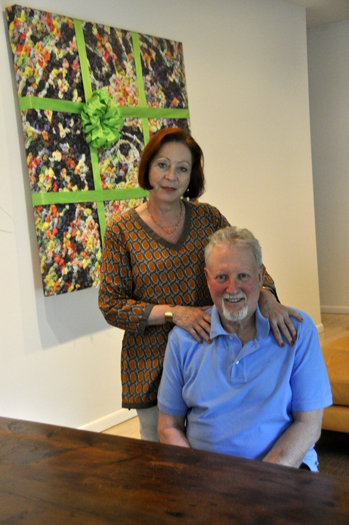
Artist Joe Zucker has no interest in the famed Hamptons light. And while he appreciates the East End’s abstract-expressionist history, Mr. Zucker wasn’t swayed to move here from Manhattan nearly 30 years ago because of it.
“The reason I came here was to stop going to clubs,” he said from his home in the Northwest Woods of East Hampton during an interview last week. “It didn’t have anything to do with north light. Many people don’t understand the practicality of the Hamptons for New York artists. Most of them move out here to get away from New York. It’s the most logical place to escape.”
Mr. Zucker began toying with the idea in 1981, he recalled. He needed a new loft in New York, but couldn’t find one that appealed to him. So he talked his now-wife, German photographer and interior designer Britta Le Va, into another option: to leave the city altogether.
The couple looked at countless properties, they said, but it was impossible. They couldn’t find the right mix of living space and artist studio.
“We came to the decision that we had to build it ourselves,” said Ms. Le Va, glancing at her husband seated next to her. “And we did that.”
The result was a simple, 3,200-square-foot house equally divided into halves—one for Mr. Zucker’s workspace, the other for their living and dining rooms, kitchen, Ms. Le Va’s
study, and the couple’s bedroom—connected by a glass atrium.
“It’s the separation of church and state,” Ms. Le Va said with a smirk.
The 3-acre property was covered with timber, the pair recalled. They traded in the oak trees to a contractor who carved out a sand road leading up to their secluded home. They were finally free of the city bustle.
“There was nobody here, nothing. It was great,” Ms. Le Va said.
“At that time, living north of the highway hadn’t quite caught on yet,” her husband said.
Since then, the couple has gained several neighbors and about 350 white pines, all planted by Mr. Zucker, he said.
“The overall plan was a loft-like, minimalist interior. And to let nature, let these rudimentary buildings be absorbed into the natural landscape,” he said.
“It wasn’t about architecture,” Ms. Le Va added. “It was about nature overtaking some invasive building.”
While the building’s design took its surroundings into account, Mr. Zucker’s work isn’t influenced by the terrain at all, he said. He is not particularly inspired by the East End’s artistic legacy or nature—including the ocean, where he spends many of his summer days fishing in Montauk.
“I’ve built a substantial body of paintings that have to do with water,” he said. “I’ve made a lot of them, but it’s not because I am particularly involved with marine paintings. You have those painters who came out here to paint the light and the sea. I don’t have anything to do with that. Only by accident.”
To Mr. Zucker, painting is somewhat unemotional and more formulated around structure, he explained. His body of work proposes that certain images, materials and processes logically combine to deliver a message. For example, in 1975, Mr. Zucker made a series of paintings concerning slavery out of cotton balls—an “elaborate pun,” he called them.
“It can be complicated, but it always has that formula,” he said. “That the work has something to do with how it’s made, what it’s made of, or a combination. And there’s no style. My style changes constantly. It’s like I’m working on one lifetime painting.”
His revolving style is reflected in his home’s sparsely-decorated living room wall. It functions as a living gallery, its one piece of artwork—always by Mr. Zucker—constantly rotating out, Ms. Le Va explained.
“When we lived together in New York, I was always living in the studio because it was one big thing, one space,” Ms. Le Va recalled. “So here, it’s nice to live with Joe’s work before it leaves the house.”
Mr. Zucker started taking classes at the Art Institute of Chicago when he was just 5 years old, he said, and eventually earned a bachelor’s degree from the school in 1964 and his master’s degree two years later.
He chose art over his second passion, basketball, but now is the assistant coach for the Bridgehampton Killer Bees. A team sweatshirt, dusty with white plaster from Mr. Zucker’s recent projects, hangs in his studio. The floor is spattered with paint—black, yellow, blue, white, green, orange and pink, to name only some of the colors.
“Since I’m not a person who’s committed to any one particular style, I, in a sense, am a cultural anarchist, which is a person who believes in the organization of chaos, not the chaos of organization,” he said. “There’s a substantial difference between the two.”
His comment evoked a laugh from his wife. The two eloped five years ago, and just last week celebrated their 34th anniversary of living together. Every year, Mr. Zucker makes a drawing for Ms. Le Va, each capturing their life together—whether it’s traveling, adopting their cat (named Joey, after his father), or moving into their East Hampton home.
“Also, complaining is what keeps you going,” Mr. Zucker continued. “If you don’t complain, you don’t continue.”
“Is that the secret to your longevity, Joe?” his wife asked.
“Yeah, it is. It drives you,” he said. “You can’t ever get complacent, no matter what the cost. Whining, complaining, bitching are part of an artist’s job.”
“Don’t tell all, Joe,” Ms. Le Va said.